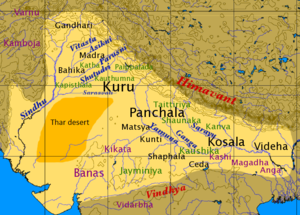利用者:3代目窓屋/sandbox
 |
ここは3代目窓屋さんの利用者サンドボックスです。編集を試したり下書きを置いておいたりするための場所であり、百科事典の記事ではありません。ただし、公開の場ですので、許諾されていない文章の転載はご遠慮ください。
登録利用者は自分用の利用者サンドボックスを作成できます(サンドボックスを作成する、解説)。 その他のサンドボックス: 共用サンドボックス | モジュールサンドボックス 記事がある程度できあがったら、編集方針を確認して、新規ページを作成しましょう。 |
英語版Wikipedia Āryāvarta (oldid=837875533)より翻訳

アーリヤーヴァルタ[1] (サンスクリット: Āryāvarta, サンスクリット語発音: [aːɾjaːˈʋəɾtə], 意味:アーリア人の住居[2]) is the term mentioned as denoting the entirety of the Indian subcontinent in some classical Hindu texts in Sanskrit such as by Patanjali and the authors of Dharmashastras. These texts also name other parts of the Indian subcontinent as Brahmavarta, Madhyadesha, Panchala and others, with neither clear boundaries nor details about who lived in them.[3][4]
Classical sources
[編集]The Manusmṛti (2.22) gives the name to "the tract between the Himalaya and the Vindhya ranges, from the Eastern Sea (Bay of Bengal) to the Western Sea (Arabian Sea)".[5][6]
The Vasistha Dharma Sutra I.8-9 and 12-13 locates the Āryāvarta to the east of the disappearance of the Sarasvati River in the desert, to the west of the Kālakavana, to the north of the Pariyatra Mountains and the Vindhya Range and to the south of the Himalayas.[7]
The Baudhayana Dharmasutra (BDS) 1.1.2.10 gives similar definitions and declares that Āryāvarta is the land that lies west of Kālakavana, east of Adarsana, south of the Himalayas and north of the Vindhyas, but in BDS 1.1.2.11 Āryāvarta is confined to the doab of the Ganges-Yamuna, and BDS 1.1.2.13-15. Patanjali's Mahābhāṣya[要出典] defines Āryāvarta like the Vasistha Dharmasutra.
The Gurjara-Pratihara king in the tenth century was titled the Maharajadhiraja of Aryavarta.[8]
See also
[編集]- Names of India
- Bharata Khanda
- アリアナ (Ariana) - 古代ギリシャとローマで知られていたイラン地域の名称。アーリア人#語源と名称の変化も参照。
- Airyanem Vaejah - 古代イランのゾロアスター教の聖典Vendīdādのうちにある語句。アーリア人たちに関連する土地を示唆する名称として考察されている。
References
[編集]- ^ アーリヤーヴァルタというカタカナ表記の例は南インド研究序説 PDFで9ページに見られる。そこでは「辛島昇 2007.南インド史の展開と南アジア.辛島 昇 編『世界歴史大系 南アジア史 3―南インド―』山川出版社.3–31.」からの引用として名前が載る。一方で日本語版Wikipediaの項目マヒシュマティにはアールヤーヴァルタという表記が載る。ここでは、アーリア人に言及する学説に関連してアーリア人に文字列が近似する前者を採用した。
- ^ Aryavarta, Monier Williams Sanskrit English Dictionary (1899)"
- ^ Madhav Deshpande (1993). Sanskrit & Prakrit, Sociolinguistic Issues. Motilal Banarsidass. pp. 80–81. ISBN 978-81-208-1136-2
- ^ Shashi Shekhar Sharma (2005). Imagined Manuvād: the Dharmaśāstras and their interpreters. Rupa & Co.. pp. 91–97
- ^ Gopal, Madan (1990). K.S. Gautam. ed. India through the ages. Publication Division, Ministry of Information and Broadcasting, Government of India. p. 70
- ^ Michael Cook (2014), Ancient Religions, Modern Politics: The Islamic Case in Comparative Perspective, Princeton University Press, p.68: "Aryavarta [...] is defined by Manu as extending from the Himalayas in the north to the Vindhyas of Central India in the south and from the sea in the west to the sea in the east."
- ^ Neelis 2010, p. 194.
- ^ André Wink (2002). Al-Hind: Early medieval India and the expansion of Islam, 7th-11th centuries. BRILL. p. 284. ISBN 978-0-391-04173-8
参考文献
[編集]- Kane, Pandurang Vaman (1962). History of Dharmaśāstra: (ancient and mediaeval religious and civil law in India). Bhandarkar Oriental Research Institute
- Neelis, Jason (19 November 2010). Early Buddhist Transmission and Trade Networks: Mobility and Exchange Within and Beyond the Northwestern Borderlands of South Asia. BRILL. ISBN 90-04-18159-8
- 元木靖「南インド研究序説」『立正大学経済学季報』第63巻第4号、2014年、157-183頁。
博物誌(英訳)6巻25章 http://www.perseus.tufts.edu/hopper/text?doc=Perseus%3Atext%3A1999.02.0137%3Abook%3D6%3Achapter%3D25
※以下、カテゴリのコメントアウト領域※
